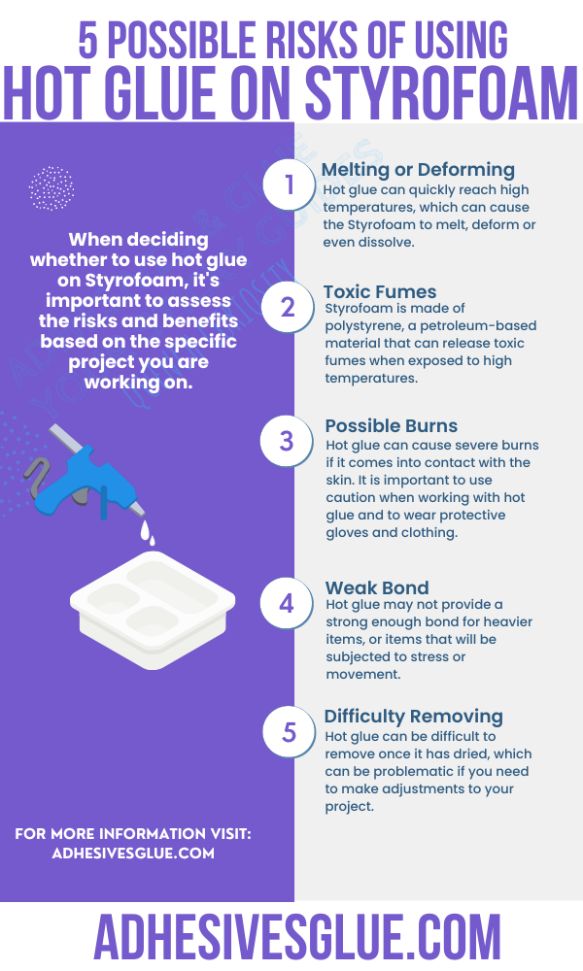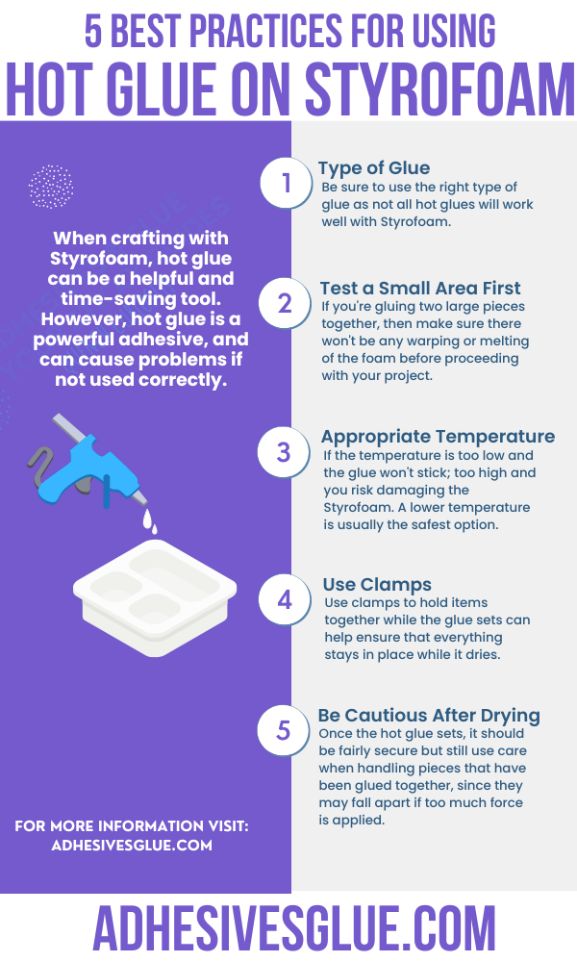If you enjoy crafting, you might be familiar with the versatile material known as Styrofoam. Have you ever thought of using it with another popular crafting tool, hot glue?
If you have, do you think we can use hot glue on styrofoam? Well, to answer that, while hot glue is a versatile adhesive that can be used for a variety of purposes, using it on Styrofoam can be risky.
This is because the heat generated by the hot glue gun can cause the Styrofoam to melt or deform, leading to a weak bond that may break apart over time.
In this blog post, we’ll take a closer look at the risks associated with using hot glue on Styrofoam, as well as some alternatives that you can use to bond this lightweight material effectively.
Contents
Understanding Styrofoam:
Let’s take a closer look at what Styrofoam is and why it can be vulnerable to damage from adhesives. Styrofoam is a type of foam plastic that is often used as a lightweight, insulating material in construction and packaging.
It is made from polystyrene, a synthetic polymer that can be extruded into a foam with a cellular structure.
The problem with using hot glue on Styrofoam is that the high temperature of the glue can cause the Styrofoam to melt or dissolve. This can lead to warping, deformation, and a weak bond that may break apart over time. The risk is even higher when working with delicate or detailed Styrofoam projects, which may be more susceptible to damage from the heat and pressure of the hot glue.

5 Possible Risks of Using Hot Glue on Styrofoam:
There are several risks when using hot glue on styrofoam, including:
1. Melting or Deforming the Styrofoam:
Hot glue can quickly reach high temperatures, which can cause the styrofoam to melt, deform or even dissolve. This can ruin your project and damage the surface you are working on.
2. Toxic Fumes:
Styrofoam is made of polystyrene, a petroleum-based material that can release toxic fumes when exposed to high temperatures. Inhaling these fumes can cause health problems, including headaches, dizziness, and respiratory issues.
3. Possible Burns:
Hot glue can cause severe burns if it comes into contact with the skin. It is important to use caution when working with hot glue and to wear protective clothing and gloves.
4. Weak Bond:
Hot glue may not provide a strong enough bond for heavier items, or items that will be subjected to stress or movement. Over time, the glue may loosen and cause the attached item to fall off.
5. Difficulty Removing:
Hot glue can be difficult to remove once it has dried, which can be problematic if you need to make adjustments to your project.
It’s important to use caution when working with hot glue on styrofoam and to consider the risks before proceeding. Always use a low-temperature hot glue gun, and work in a well-ventilated area to avoid inhaling toxic fumes.
4 Alternatives to Hot Glue on Styrofoam:
If you are looking for a safer and more effective way to bond Styrofoam, there are a number of foam-safe adhesives that are designed to work specifically with this type of material. These adhesives are formulated to create a strong bond without damaging the Styrofoam.
There are several alternatives to hot glue that can be used to attach items to styrofoam:
1. Double-Sided Tape:
Double-sided tape can be an effective alternative to hot glue for attaching lightweight items to styrofoam. This is a good option when working with delicate or small items.
2. Foam-Safe Adhesive:
There are specific adhesives designed to work with foam products like styrofoam. These adhesives are typically water-based and can be used for a variety of projects. They are less likely to damage the styrofoam and are a good option for projects that require a stronger bond.
3. Epoxy Glue:
Epoxy glue is a two-part adhesive that creates a strong bond and is suitable for heavier items. It’s important to choose an epoxy glue that is specifically designed for use with styrofoam.
4. Tacky Glue:
Tacky glue is a popular choice for craft projects and can be used on styrofoam. It is a water-based glue that dries clear and is easy to use.
When selecting an alternative adhesive to hot glue, it’s important to consider the weight and type of item being attached, as well as the materials being used. Always follow the manufacturer’s instructions and use caution when working with adhesives.

5 Best Practices for Using Hot Glue on Styrofoam:
When crafting with styrofoam, hot glue can be a helpful and time-saving tool. It’s important to remember, however, that hot glue is a powerful adhesive and can cause problems if not used correctly. Here are some tips to keep in mind when using hot glue on styrofoam:
1. Type of Glue:
Be sure to use the right type of glue as not all hot glues will work well with styrofoam. Do your research and make sure you’re using glue specifically designed for use on foam materials.
2. Test a Small Area First:
This is especially important if you’re gluing two large pieces together. Make sure there won’t be any warping or melting of the foam before proceeding with your project.
3. Choose an Appropriate Temperature:
If the temperature is too low and the glue won’t stick; too high and you risk damaging the styrofoam. The safest option is usually to start at a lower temperature and only increase it if necessary.
4. Take Advantage of Clamps:
Use clamps to hold items together while the glue sets can help ensure that everything stays in place while it dries.
5. Be Cautious Even After Drying:
Once the hot glue sets, it should be fairly secure but still use care when handling pieces that have been glued together, since they may fall apart if too much force is applied.
Conclusion:
In conclusion, using hot glue on Styrofoam can be risky, as it can cause the material to melt or dissolve, leading to deformation and a weak bond that may break apart over time.
However, by following best practices and using foam-safe glue or other alternatives, you can bond Styrofoam effectively without damaging the material.
If you are unsure about which glue to use or how to apply it, be sure to consult the manufacturer’s instructions or seek advice from a professional.

I fell in love with crafts & fixing things when I was 11 years old – after discovering the world of blogging, I am combining my passions to present the world with well-researched guides & reviews about everything related to adhesives & glue.